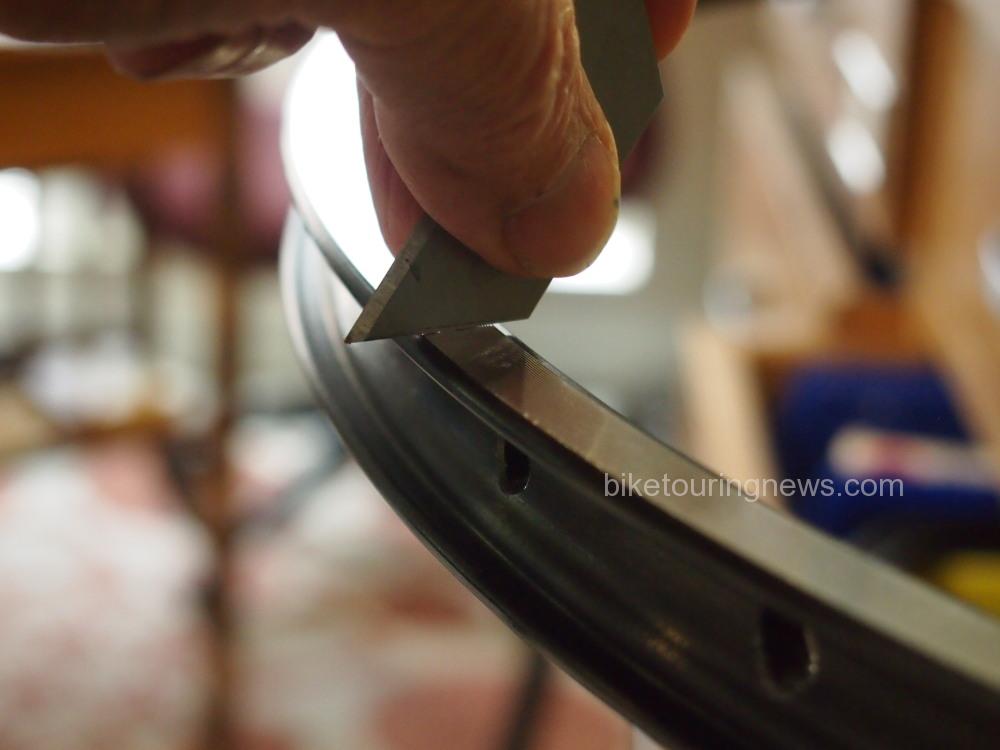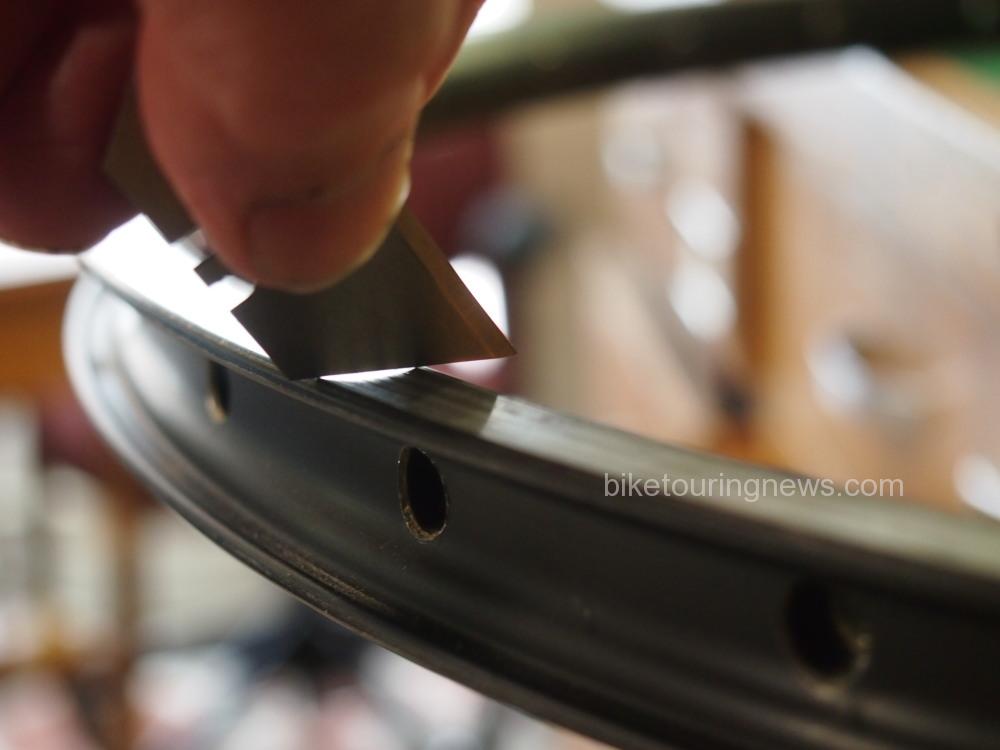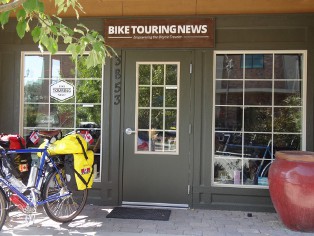It’s early morning in Moab, Utah when the still air is violated by the sound of a small explosion and the clang of scraping metal. My friend’s rear wheel has come apart and is a twisted jumble of aluminum rim, steel spokes and rubber. For the first time, I realize that soft rubber brake pads can wear through metal. Sand and other grit in a slurry with oil and who knows what other chemicals get embedded in the pads and act like a grinding disc to wear away at the relatively soft aluminum braking surface of the rim. Once the braking surface becomes too thin to provide structure to the rim, the forces of the tire bead can blow it apart. Here is a visual example of what I am talking about.

The braking surface on a new rim is flat, if not a little concave.

A worn rim braking surface.
The concavity of the worn rim is visually apparent, but it can also be felt by the fingertips. Lots of times this is just a judgment call. Some rim makers machine a groove in the circumference of the rim’s braking surface and others create three or four small dots or indented holes at intervals around the rim. Once these indicators are no longer visible it is time to replace the rim.
Check your rim brake bicycle’s rims. If the braking surface feels like it has a little concavity to it, replace it before you go on the next long tour.

Tucker Anderson March 22, 2016, 9:55 pm
Also be weary of long, fast decents with rim brakes if you have a heavy load. The Clyclotherapy ‘tourists’ that visted last year, blew a tire coming down Whitebird Grade.
Bike Hermit® March 23, 2016, 11:54 am
Tucker,
Yep, rim brakes can build up a lot of heat in the rim: enough to blow tires on long downhills.
hopi/sho-pai March 23, 2016, 1:32 pm
GOOD THING FOR DISC BRAKES ON ALL MY BICYCLES.
Slowspoke March 24, 2016, 8:40 am
Always ride uphill, like I do.
fredbyte March 24, 2016, 9:45 am
Yes, I once had a rim blow out my rear tire while riding around town. Luckily, I was about 1 mile from home. If you ride a lot, the rims will start to go concave with rim brakes. The question is how far to push your luck? When I build my wheels, I now measure the thickness of the side walls with a long-reach vernier caliper, which has protruding nubs rather than a straight edge, so you can get over the bead for a measurement. Many rims have about 1.0 mm or less of aluminum. The better ones have 1.5 mm or more. So, I’m now leaning toward the thicker wall rims to build my wheels. I haven’t made measurements recently, so I can’t recall which rims they are. But if you’re interested, reply to this post, and I’ll go find and measure those rims.
Phillip Bissell, Australia March 24, 2016, 9:51 pm
Very good advice, Jim. Perhaps seldom thought of by cyclists. I for one, in many years of bicycle touring and cycling in general, had not quite realised the potential disaster that a worn rim could present. This is the first time I have heard of a rim falling apart in the manner you describe. Not worth the risk, eh?
Bike Hermit® March 25, 2016, 1:14 pm
Not worth the risk indeed. Could have been much worse.
Craig Montgomery, Tucson March 27, 2016, 8:56 am
I think we’re talking a “low-probability event” here. If rims were dying at pandemic rates then yea I’d be howling like a banshee and flailing my arms too but we may be looking at what fredbyte noticed: the cheapening of rims in our new world order. Let me play the grizzled old curmudgeon. I’ve been road/backroad touring on the same 700c touring wheels (Wolber Model 58’s laced to Suntour hubs) since 1987 with no sign of any concavity. Though most of my camptouring is on 650B now, I still light road tour on these wheels to this day. So I suggest you build with the best (thickest) and do something I’ve been doing for 40 years: clean your rims and pads, even (especially) during tours. It’s amazing what some simple basic maintenance will do to keep quality equipment going.
Wayne March 27, 2016, 10:14 pm
Go with the thickest, toughest mothers you can get — Ryde CSS Andra 30s — and you’ll ride with total peace of mind: http://www.cyclingabout.com/the-best-rims-for-bicycle-touring/ (the Andras are on my ol’ 26er).
Whatta they look like after, say, 17,000 kms? Have a gander: https://www.crazyguyonabike.com/reviews/board/message/?o=tS&message_id=183714&v=J&replies=1#replies . Thorn bikes recommends them for their expedition bikes but suggests the CSS version in the back only with the regular Andra up front (which is what I did). For more info and reasoning on that front-rear set-up, read the Thorn Mega Brochure. I have canti brakes and use the Kool Stop Eagle Claw RIGIDA model of brake pad on the rear CSS rim. That brake pad is made specifically for the CSS application and is available from SJS in the UK http://www.sjscycles.co.uk/koolstop-koolstop-eagle-2-cantilever-blocks-post-mount-for-rigida-carbide-rims-prod19779/ or http://www.sjscycles.co.uk/koolstop-koolstop-v-brake-block-inserts-for-rigida-carbide-rims-prod19778/ . These are scarce on the ground in North America and the best idea is to contact the Koolstop folks in Oregon http://www.koolstop.com/english/corporate.html and see what they can do for you. I bought my pads directly from them as I’m in Canada.
My experience with lesser rims — I blew through a Velocity Aeroheat in little more than 2,000km — had me turn to the Andras and I’ll never use anything else regardless of the extra weight.